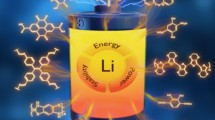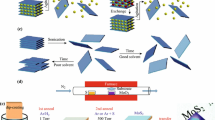Abstract
Context
In this paper, we simulate a single-molecule diode to calculate the effective coupling and investigate the conductivity, as well as the effect of the electric field on these two parameters. First, we obtain the molecule states and energies at 0 V. The next step is to calculate the electrode/molecule coupling using the obtained electrode and molecule Hamiltonian. The electrode/molecule coupling depends on distance. By increasing the distance from 5 to 5.5 angstroms, the coupling decreases from 0.004 to 0.0002 eV. After calculating the electrode/molecule coupling, which is the most significant parameter in electron transfer, the results can be used to obtain the current-voltage and conductivity curves of the device. Simulation results demonstrate that externally applied electric field to the benzene molecule (isolated molecule) can cause a reduction in the effective coupling between the Au electrode and benzene, leading to decreased current and conductivity. Additionally, the applied electric field narrows the gap between the HOMO and LUMO energy levels.
Methods
We conducted this computational work using Gaussian 09 software and a MATLAB code, both of which are based on the density functional theory (DFT) approach and the self-consistent field (SCF) method. For DFT calculations, we employed the three-parameter Beck hybrid exchange functional (B3), hybridized with the nonlocal correlation functional developed by Lee, Yang, and Parr (LYP). All optimizations were performed with triple-zeta polarized (TZP) split-valence 6-311G basis sets. The final step involved calculating the electrode/molecule coupling using the Huckel method and integrating the site-to-state transformation with Huckel parameters and the Fermi golden rule. After this calculation, we obtained the current-voltage and conductivity curves using MATLAB software.










Similar content being viewed by others
Data availability
The datasets generated and analyzed during the current study are available from the corresponding author on reasonable request.
References
Batra A, Darancet P, Chen Q, Meisner JS, Widawsky JR, Neaton JB et al (2013) Tuning rectification in single-molecular diodes. Nano Lett 13:6233–6237
Batra A, Meisner JS, Darancet P, Chen Q, Steigerwald ML, Nuckolls C et al (2014) Molecular diodes enabled by quantum interference. Faraday Discuss 174:79–89
Bushong N, Sai N, Di Ventra M (2005) Approach to steady-state transport in nanoscale conductors. Nano Lett 5:2569–2572
Chen H, Fraser Stoddart J (2021) From molecular to supramolecular electronics. Nat Rev Mater 6:804–828
Chen L, Hansen T, Franco I (2014) Simple and accurate method for time-dependent transport along nanoscale junctions. J Phys Chem C 118:20009–20017
Chen LL, Zhao L, Wang ZG, Liu SL, Pang DW (2022) Near-infrared-II quantum dots for in vivo imaging and cancer therapy. Small 18:2104567
Datta S (2004) Electrical resistance: an atomistic view. Nanotechnology 15:S433
Datta S (2005) Quantum transport: atom to transistor. Cambridge University press
Di Ventra M, Todorov TN (2004) Transport in nano scale systems: the microcanonical versus grand-canonical picture. J Phys Condens Matter 16:8025
Garrigues AR, Yuan L, Wang L, Mucciolo ER, Thompon D, Del Barco E et al (2016) A single-level tunnel model to account for electrical transport through single molecule-and self-assembled monolayer-based junctions. Sci Rep 6:26517
Hod O, Kronik L (2023) The Driven Liouville von Neumann approach to electron dynamics in open quantum systems. Israel J Chem 63:e202300058
Huang Y-M, Singh KJ, Liu A-C, Lin C-C, Chen Z, Wang K et al (2020) Advances in quantum-dot-based displays. Nanomaterials 10:1327
Jha D, Dixit A, Sushrutha A, Patel PK (2022) Optical simulations and optimization of highly efficient GaAs based quantum dot solar cell. Opt Commun 523:128717
Karmakar S (2022) Ternary logic flip-flops using quantum dot gate field effect transistor (QDGFET). Silicon 14:12553–12565
Kim T, Liu Z-F, Lee C, Neaton JB, Venkataraman L (2014) Charge transport and rectification in molecular junctions formed with carbon-based electrodes. Proc Natl Acad Sci 111:10928–10932
Klimov VI (2010) Nanocrystal quantum dots. CRC Press
Kornilovitch P, Bratkovsky A, Williams RS (2002) Current rectification by molecules with asymmetric tunneling barriers. Physical Review B 66:165436
Lin Y, Zhan X (2013) Organic solar cells based on small molecules. Organ Optoelectron:375–405
Liu Z-F, Neaton JB (2017) Voltage dependence of molecule–electrode coupling in biased molecular junctions. J Phys Chem C 121:21136–21144
Paulsson M, Zahid F, Datta S, Goddard W (2003) Handbook of nanoscience, engineering and technology. CRC Press, Boca Raton, FL
Peng H, Li Q, Hu M, Xiao L, Lu J, Zhuang L (2018) Alkaline polymer electrolyte fuel cells stably working at 80° C. J Power Sources 390:165–167
Perrin ML, Galan E, Eelkema R, Grozema F, Thijssen JM, van der Zant HS (2015) Single-molecule resonant tunneling diode. J Phys Chem C 119:5697–5702
Ramachandran K, Deepa G, Namboori K (2008) Computational chemistry and molecular modeling: principles and applications. Springer Science & Business Media
Rossi TP, Shegai T, Erhart P, Antosiewicz TJ (2019) Strong plasmon-molecule coupling at the nanoscale revealed by first-principles modeling. Nat Commun 10:3336
Sánchez CG, Stamenova M, Sanvito S, Bowler D, Horsfield AP, Todorov TN (2006) Molecular conduction: do time-dependent simulations tell you more than the Landauer approach. J Chem Phys 124:214708
Taubmann G (1992) Calculation of the Hückel parameter β [beta] from the free-electron model. J Chem Educ 69(2):96
Taylor J, Brandbyge M, Stokbro K (2002) Theory of rectification in tour wires: the role of electrode coupling. Phys Rev Lett 89:138301
Tian D, Ma H, Huang G, Gao M, Cai F, Fang Y et al (2023) A review on quantum dot light-emitting diodes: from materials to applications. Adv Opt Mater 11:2201965
Verzijl C, Seldenthuis J, Thijssen J (2013) Applicability of the wide-band limit in DFT-based molecular transport calculations. J Chem Phys 138:094102
Wu J, Wang ZM (2014) Quantum dot molecules. Springer
Xiang D, Wang X, Jia C, Lee T, Guo X (2016) Molecular-scale electronics: from concept to function. Chem Rev 116:4318–4440
Xue X, Chen M, Luo Y, Qin T, Tang X, Hao Q (2023) High-operating-temperature mid-infrared photodetectors via quantum dot gradient homojunction. Light Sci Appl 12:2
Yates K (2012) Hückel molecular orbital theory. Elsevier
Zelovich T, Hansen T, Tuckerman ME (2022) A Green’s function approach for determining surface induced broadening and shifting of molecular energy levels. Nano Lett 22:9854–9860
Zelovich T, Kronik L, Hod O (2014) State representation approach for atomistic time-dependent transport calculations in molecular junctions. J Chem Theory Comput 10:2927–2941
Zelovich T, Kronik L, Hod O (2015) Molecule–lead coupling at molecular junctions: relation between the real-and state-space perspectives. J Chem Theory Comput 11:4861–4869
Zhou L, Neukirch AJ, Vogel DJ, Kilin DS, Pedesseau L, Carignano MA et al (2018) Density of states broadening in CH3NH3PbI3 hybrid perovskites understood from ab initio molecular dynamics simulations. ACS Energy Letters 3:787–793
Acknowledgements
The authors would like to thank Mr. Saeed Talei with the University of Miskolc, Hungary for helping us with Gaussian software simulations.
Author information
Authors and Affiliations
Contributions
Design, analysis, and investigation: MM, writing—original draft preparation: MM, writing—review and editing: MD, supervision: MD.
Corresponding author
Ethics declarations
Ethical approval
We the undersigned declare that the manuscript entitled “A single molecule diode based on gold electrodes and benzene molecule: Conductivity and coupling analysis” is original, has not been fully or partly published before, and is not currently being considered for publication elsewhere. Also, results are presented clearly, honestly, and without fabrication, falsification, or inappropriate data manipulation. We confirm that the manuscript has been read and approved by all named authors and that there are no other persons who satisfied the criteria for authorship but are not listed. We further confirm that the order of authors listed in the manuscript has been approved by all of us.
Consent to participate
Not applicable
Consent for publication
Not applicable
Conflict of interest
The authors declare no competing interests.
Additional information
Publisher’s Note
Springer Nature remains neutral with regard to jurisdictional claims in published maps and institutional affiliations.
Rights and permissions
Springer Nature or its licensor (e.g. a society or other partner) holds exclusive rights to this article under a publishing agreement with the author(s) or other rightsholder(s); author self-archiving of the accepted manuscript version of this article is solely governed by the terms of such publishing agreement and applicable law.
About this article
Cite this article
Malek, M., Danaie, M. A single molecule diode based on gold electrodes and benzene molecule: conductivity and coupling analysis. J Mol Model 29, 332 (2023). https://doi.org/10.1007/s00894-023-05740-z
Received:
Accepted:
Published:
DOI: https://doi.org/10.1007/s00894-023-05740-z




